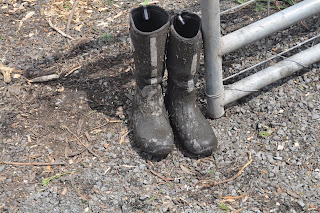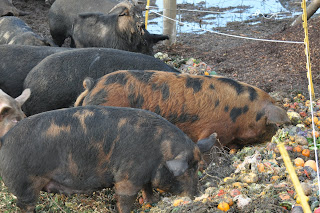
I spent the weekend interviewing people for a couple of farmhand positions I've got, and this post is a collection of observations and comments about my experience. The unfortunate thing is that I only need 2 people; i wish I had 100 jobs to offer. So if you weren't selected and are reading this, please don't take it personally.
I
wrote an ad that I thought accurately described what people would be doing, and what the basic requirements for the position were, and then I posted this ad onto my blog and the local craigslist. I received the first response less than 5 minutes after I posted the ad, and by noon the next day I had over 100 applicants. I ended up with 180 applicants before I took the ad down.
Over the course of my working life I've probably interviewed 700 or 800 people; most of the folks that I interviewed were in the context of engineering -- the company I worked for hired continuously the entire time I was working there, and so I'd often interview 7 or 10 people a week, usually an hour at a time, as well as doing my regular job.
What I'm after when I interview someone is to get a feel for how they approach their work. Specific skills you can teach, but you can't teach someone their approach -- my experience is that how they approach their job is a really deeply rooted part of each person, and so my goal is to get a glimpse of that.
So for an engineer, you talk them through a problem that you know they probably don't already know the answer to -- an example of this might be "How many gas stations are there in the USA?"
But that's for engineers. For a farm hand, I need a pretty broad individual, who has a basic skill set that allows them to solve the problems they'll run across; carpentry to fix the broken gate or fence. A good sense for herding animals because they get out sometimes, or need to be moved around. A positive attitude because this isn't a milk carton -- you have bad days on the farm, too.
The other problem I had is that I had way too many people apply. I wanted to have some objective way to feel better about why I chose one person vs another.
My business experience has been that hiring, especially your first few hires, is crucial to the success of your business. if you can hire a good person, that person will make your life as a business owner better. And it's worth the effort to put yourself out there and look for the right person.
The first thing that I asked them to do is to fill out an application on arrival; I had each applicant carry it with them. if they didn't work out for whatever reason, they took it with them. That way at the end of the day the applications I had were for folks that had the basic qualifications. As they completed each interview step we'd make some notes and they'd carry it to the next step. So it was a 3 page deal, 2 page generic application, and a third page with an area for notes for my use.
Basic hand tools used in interview
The first task I had everyone do:
"I want you to take a 2x4, and make me a square that is 11.5", as if you were going to put it over an 11.5" square pillar"
What this told me is whether they could listen to directions, and then translate what they've heard into physical form using basic hand tools. A saw, hammer and a tape measure, all of which they'd have to use at some point on the farm. It also require simple math, and (and this is the secret) whether they check their work before they present it.
I had 5 people walk away at this point. One woman said "I only gave myself 20 minutes to be interviewed, and I have to go", which I thought was odd. If you're looking for a job, isn't your schedule pretty clear? Or shouldn't it be?
The first day I'd pass people who couldn't do a box on to the next steps, but on the 2nd and 3rd days, I just told them point-blank -- "good job, you can move on", or "I'm sorry, but this isn't a pass. Thank you for applying"
There was one applicant who i really liked on Sunday, day 2 -- personable, good eye contact, just generally a pleasure, and when they didn't make the box work the first time I told them that, and against my usual policy I gave them a second chance. I think it was harder for them when I said no the second time. No matter how much I liked someone personally, I did have to keep it clear in my head that I was hiring for a particular task, and i really did need the skills listed. 5 people didn't start, and 10 people didn't successfully complete their box.
Some of these are good
On day 1 I had a second carpentry task,
making a simple sawhorse. I dropped this on the second day -- people that couldn't pass the box test couldn't do the sawhorse either, and people who did pass the box test were all able to make the sawhorse. the only new information I got was how fast they completed the chore.
But i did end up with a bunch of sawhorses.
The second task was working with the pigs
Andrea handled the majority of this; we had the people move various sows through our corral and loading chute. We picked friendly sows, but we needed to know if people had an issue working with an animal that outweighed them 3 to 1 or more.
what we found is that we could really tell pretty quickly who had an affinity for animals, and could work with them. There was one standout applicant that didn't have much experience with animals, but did listen to Andrea, and did what she said. I was a bit surprised that more people didn't listen to the instructions carefully, but that's part of what we need to know. Particularly with pigs, we (Andrea and I) know more about our herd than anyone else. The ability to listen to us about the pigs is crucial.
5 or so didn't do well in this step.
The third was working with equipment
We had them hop on a small tractor and dig a little with the backhoe. Some of the people had obviously used a backhoe before -- and that was noted. For those without the experience, we looked at how they reacted to a novel experience - and again, how they listened and followed direction. We want the farmhand to be able to work independently (as soon as they can!) but initially, we'll be teaching them.
We only had 1 person who didn't do this step.
And the fourth was the lifting and agility.
Farm work requires physical labor at some point or other. 50lb sacks of feed, or minerals. Bales of hay. Animals. Hand tools -- you'll be lifting or carrying or moving something every day.
We had them move 4 or 6 bales of hay about 20', and then climb in and out of our big tractor. What we found is that roughly half of the people who applied were breathing heavily after moving 4 bales of hay. Another 3rd didn't have the strength or agility to pull themselves into the tractor.
When you're working with large animals, especially in pens, you will need to be able to hop out of the pen, or climb the corral wall, or a gate, quickly, at some point or another. The tractor showed us who had the basic physical requirements to do that.
With the heavy lifting, I did ask that folks be in decent shape, and I had to wonder what that means to people. If 3 minutes of moving bales is going to require that they take a rest break, I'm not sure what they'll do when we're haying. If you can't lift a 60lb bale from the ground to waist height, you can't feed the cows.
The range of background and experience offered was pretty amazing -- but some of the best candidates didn't show up. The fellow who'd worked on a 3,000 sow hog farm, and had all of the basic pig stuff under his belt -- I was actually looking forward to talking to him. Noshow. The vet student who was home for the summer. The welder who had finished his courses but couldn't find steady work, so was looking to supplement his income. Mysteries, all.
This is a deep recession we're in. I would have never gotten this sort of, or this quality of, responses to this job 4 years ago.
I wish I had 100 jobs to offer.





























